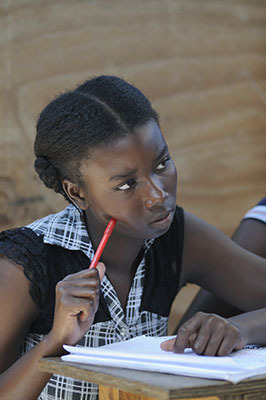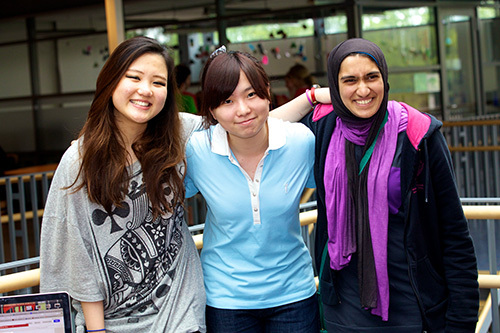
“Low Performing Students: Why They Fail and How to Help Them Succeed” is a new analysis of previously published PISA data which discusses the factors affecting students’ low performance on PISA together with recommendations for what countries can do to help their students.
In my interview with Andreas Schleicher, Eğitim ve Beceriler Direktörü, Special Advisor on Education Policy to the Secretary-General at the Organization for Economic Co-operation and Development, we discussed the cycle of poor student performance in at-risk communities, the key characteristics of schools that affect the level of performance, how government policy can support students, and the relevance of the PISA test in a changing education environment.
Andreas: What surprised you most about the Low-Performing Students: Why They Fall Behind and How to Help Them Succeed report and why?
I was surprised how little the economic and social background of schools and countries contributes to the risk of poor performance, and how much school policy can really do about it. And you find that reflected in the progress which some of those countries that had made this a priority have achieved in reducing the share of poor performers. Örneğin, Brezilya, Almanya, İtalya, Meksika, Polonya, Portekiz, Tunisia and Turkey significantly reduced the share of low performers in math between 2003 ve 2012. What do these countries have in common? Not very much; as a group, they are about as socio-economically and culturally diverse as can be. But therein lies the lesson: all countries can improve their students’ performans, given the right policies and the will to implement them.

How destructive is the cycle of poor student performance in at-risk communities? How does the cycle of intergenerational low-achievement affect a large country (ABD'yi. Örneğin) as a whole?
Poor performance at school has long-term consequences that are hard to compensate, both for individuals and nations. Students who perform poorly at age 15 face a high risk of dropping out of school altogether. And when a large share of the population lacks basic skills, a country’s long-term economic growth is severely compromised. Aslında, Çünkü kötü eğitim politikaları ve uygulamalarının kaybolur ekonomik çıkış ekonomik durgunluk kalıcı bir duruma ne miktarda birçok ülkede yaprak – ve bir o binyılın başında finansal krizden kaynaklanan bir daha büyük ve daha derin olabilir. Think about the United States: If all 15-year-old Americans would achieve at least the most basic level of PISA performance, the US economy could gain an additional 27 trillion US$ over the working life of these students. Elbette, one can always question whether it makes sense to establish global benchmarks for low performance in a highly diverse set of countries that place very different demands on the skills of individuals. But this report sets the bar at a very basic level of performance that we should expect all 21st century youths to attain. In reading, it is the threshold where students more from being able to technically read towards using reading for learning. In mathematics, it involves a basic understanding of fundamental mathematical concepts and operations. And it is interesting that educational policy and practice is a much more powerful predictor for the share of students who are missing this bar than income per capita.
We also need to recognize that poor performance at age 15 is not the result of any single risk factor, but rather of a combination and accumulation of various barriers and disadvantages that affect students throughout their lives. Who is most likely to be a low performer in mathematics? Ve OECD ülkeleri ortalaması olarak, a socio-economically disadvantaged girl who lives in a single-parent family in a rural area, has an immigrant background, speaks a different language at home from the language of instruction, had not attended pre-primary school, had repeated a grade and is enrolled in a vocational track, has a 83% probability of being a low performer. While these background factors can affect all students, among low performers the combination of risk factors is much more detrimental to disadvantaged than to advantaged students. Gerçekten, all of the demographic characteristics considered in our report, as well as the lack of pre-primary education, increase the probability of low performance by a larger margin among disadvantaged than among advantaged students, OECD ülkeleri arasında ortalama. Tersine, only repeating a grade or enrollment in a vocational track has greater penalties for advantaged students. Başka bir deyişle, disadvantaged students tend not only to be encumbered with more risk factors, but those risk factors have a stronger impact on these students’ performans.

Education Reform has become more focused on designing curricula that can best serve the trends and challenges facing our world. Given this critical big picture debate, how does the PISA test remain relevant?
That is precisely what PISA is about. The PISA test is less concerned with whether students can reproduce specific subject matter content, but more whether they can creatively use, apply and extrapolate from what they know. That’s because the modern world no longer rewards us just for what we know – Google knows everything – but for what we can do with what we know.
How important are the characteristics of schools, öğretmenlerin dahil, resources and student body composition, in affecting the incidence of low-performing students?
Önemlisi, students attending schools where teachers are more supportive and have better morale are less likely to be low performers, while students whose teachers have low expectations for them and are absent more often are more likely to be low performers in mathematics, even after accounting for the socio-economic status of students and schools.
Ek olarak, in schools with larger concentrations of low performers, the quality of educational resources is lower, and the incidence of teacher shortage is higher, OECD ülkeleri arasında ortalama, even after accounting for students’ ve okullar’ socio-economic status. In countries and economies where educational resources are distributed more equitably across schools, there is less incidence of low performance in mathematics, and a larger share of top performers, even when comparing school systems whose educational resources are of similar quality.
The report also shows that the degree to which advantaged and disadvantaged students attend the same school (sosyal içerme) is more strongly related to smaller proportions of low performers in a school system than to larger proportions of top performers. These findings suggest that systems that distribute both educational resources and students more equitably across schools might benefit low performers without undermining better-performing students.

What are the key policy proposals that the OECD strongly recommends be adopted by countries with a high level of low performing students?
The first step for policy makers is to make tackling low performance a priority in their education policy agenda. Because the profile of low performers varies significantly across countries, it is essential to identify low performers and develop multi-pronged, tailored approaches. Tackling low performance requires stepping in as early as possible. That means, Diğer şeylerin yanı sıra, offering pre-primary education opportunities and remedial support in early grades. Providing schools with language and/or psycho-social support (örneğin. psikologlar, mentorların, counsellors) for struggling students and their families, offering extracurricular activities, and training teachers to work with these students can also help. Öğrenciler, çok, can help themselves make the most of their schooling – and their own potential – by showing up at school – on time – and investing their best efforts in learning.
(Tüm fotoğraflar Shutterstock.com nezaket vardır)

C. M. Rubin ve Andreas Schleicher
Sir Michael Barber dahil bana katılın ve dünyaca ünlü düşünce liderleri (İngiltere), Dr. Michael Blok (ABD), Dr. Leon Botstein (ABD), Profesör Clay Christensen (ABD), Dr. Linda Darling-Hammond (ABD), Dr. MadhavChavan (Hindistan), Profesör Michael Fullan (Kanada), Profesör Howard Gardner (ABD), Profesör Andy Hargreaves (ABD), Profesör Yvonne Hellman (Hollanda), Profesör Kristin Helstad (Norveç), Jean Hendrickson (ABD), Profesör Rose Hipkins (Yeni Zelanda), Profesör Cornelia Hoogland (Kanada), Sayın Jeff Johnson (Kanada), Bayan. Chantal Kaufmann (Belçika), Dr. EijaKauppinen (Finlandiya), Devlet Bakanı TapioKosunen (Finlandiya), Profesör Dominique Lafontaine (Belçika), Profesör Hugh Lauder (İngiltere), Rab Ken Macdonald (İngiltere), Profesör Geoff Masters (Avustralya), Profesör Barry McGaw (Avustralya), Shiv Nadar (Hindistan), Profesör R. Natarajon (Hindistan), Dr. PAK NG (Singapur), Dr. Denise Pope (ABD), Sridhar Rajagopalan (Hindistan), Dr. Diane Ravitch (ABD), Richard Wilson Riley (ABD), Sir Ken Robinson (İngiltere), Profesör Pasi Sahlberg (Finlandiya), Profesör Manabu Sato (Japonya), Andreas Schleicher (PISA, OECD), Dr. Anthony Seldon (İngiltere), Dr. David Shaffer (ABD), Dr. Kirsten Sürükleyici Are (Norveç), Başbakan Stephen Spahn (ABD), Yves Theze (ABD LyceeFrancais), Profesör Charles Ungerleider (Kanada), Profesör Tony Wagner (ABD), Sir David Watson (İngiltere), Profesör Dylan Wiliam (İngiltere), Dr. Mark Wormald (İngiltere), Profesör Theo WUBBELS (Hollanda), Profesör Michael Young (İngiltere), ve Profesör Minxuan Zhang (Çin) Onlar bütün milletler bugün karşı karşıya büyük resmi eğitim soruları keşfetmek gibi.
Eğitim Toplum Page Global Arama
C. M. Rubin o aldığı için iki çok okunan çevrimiçi serisinin yazarı 2011 Upton Sinclair ödülü, “Eğitim Global Arama” ve “Nasıl Oku Will?” O da üç çok satan kitapların yazarı, Dahil Harikalar Gerçek Alice, yayıncısıdır CMRubinWorld, ve bir Disruptor Vakfı Fellow.






Son Yorumlar